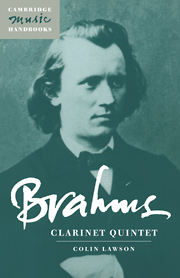Book contents
- Frontmatter
- Contents
- List of illustrations
- Preface
- 1 The nineteenth-century clarinet and its music
- 2 Brahms and the orchestral clarinet
- 3 Brahms's chamber music before 1891
- 4 The genesis and reception of the Clarinet Quintet
- 5 Design and structure
- 6 Performance practice
- 7 The legacy of Brahms's clarinet music
- Appendix 1 A list of Brahms's chamber music
- Appendix 2 A review of the first London performance,The Times,29 March 1892
- Appendix 3 The mechanism of Mühlfeld's Baermann-Ottensteiner clarinets
- Notes
- Select bibliography
- Index
7 - The legacy of Brahms's clarinet music
Published online by Cambridge University Press: 05 June 2012
- Frontmatter
- Contents
- List of illustrations
- Preface
- 1 The nineteenth-century clarinet and its music
- 2 Brahms and the orchestral clarinet
- 3 Brahms's chamber music before 1891
- 4 The genesis and reception of the Clarinet Quintet
- 5 Design and structure
- 6 Performance practice
- 7 The legacy of Brahms's clarinet music
- Appendix 1 A list of Brahms's chamber music
- Appendix 2 A review of the first London performance,The Times,29 March 1892
- Appendix 3 The mechanism of Mühlfeld's Baermann-Ottensteiner clarinets
- Notes
- Select bibliography
- Index
Summary
Introduction: clarinet music after Brahms
After the brilliant creations of Brahms and Reger, public interest in the clarinet as a chamber music instrument seemed to become strangely paralysed. But today, thanks to the efforts of outstanding players and chamber music circles, the clarinet has regained its rightful place in the concert hall, especially as the radio has for many years made wide use of the solo player. Numerous works with solo clarinet have been written in recent decades, and most of them far exceed the level of the average work composed at the turn of the century…
So wrote the German clarinettist Oscar Kroll in a book which was in preparation during the 1930s. At the beginning of the twentieth century the most enduring composers for the clarinet seem to have been those with their own individual mode of expression rather than subscribers to the Brahms tradition. In radically expanding the clarinet's expressive range, Berg caused surprise and astonishment with his Vier Stücke Op. 5 (1913), damned with faint praise in Tuthill's article in Cobbett as ‘Very outré; interesting as studies in effects’. Meanwhile, the French school continued to flourish in its own distinctive vein, Debussy contributing a masterly and taxing example of the solo de concours with his Première rapsodie of 1910. The solo clarinet repertory was also soon to be imbued with jazz influence (Stravinsky) and neoclassical traits (Krenek and others).
- Type
- Chapter
- Information
- Brahms: Clarinet Quintet , pp. 81 - 87Publisher: Cambridge University PressPrint publication year: 1998



